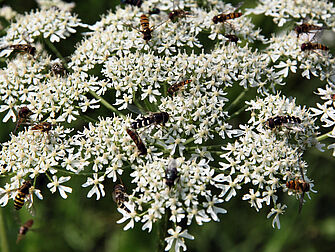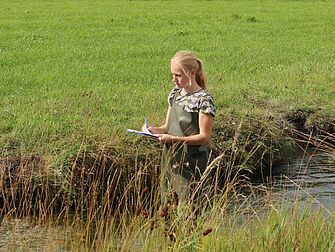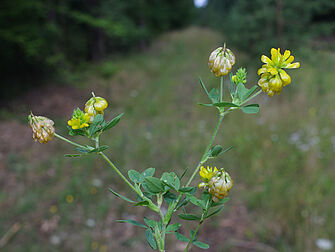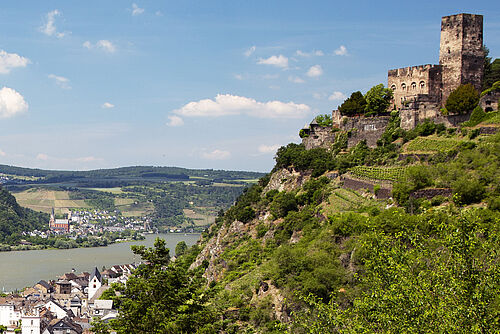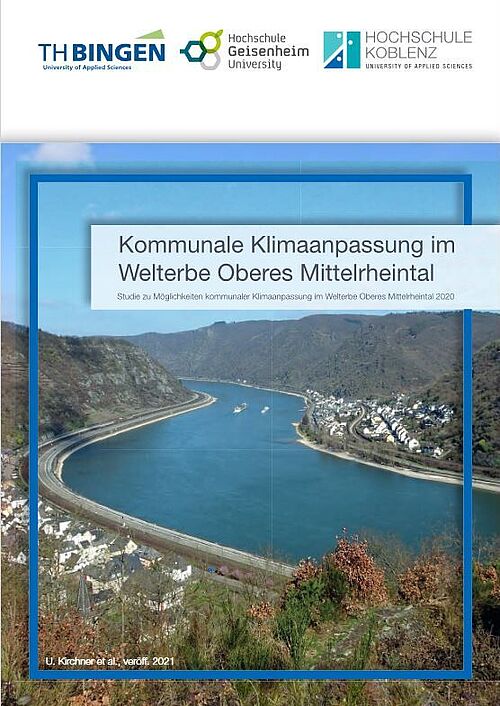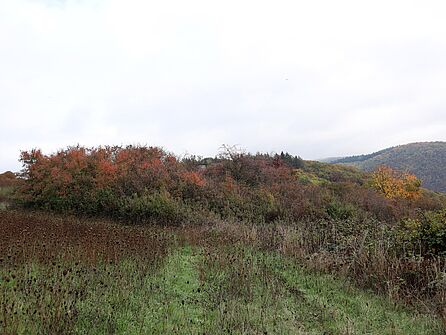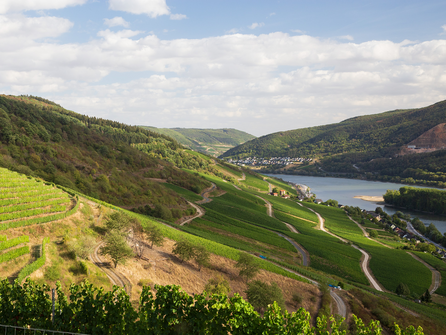[Translate to English:] Projekte
[Translate to English:]
Die folgende Auswahl aktueller Projekte gibt Ihnen einen ersten Einblick in einige der Themen, mit denen sich die Forschenden des Instituts für Landschaftsplanung und Naturschutz derzeit beschäftigen.
In-situ-Erhaltung von Wildpflanzen
Research projects
On this page you will get an insight into the research and projects that the researchers of the Institute of Landscape Planning and Conservation are currently working on.
→ Municipal climate adaptation in the Upper Middle Rhine Valley World Heritage Site
In situ conservation of wild plants for food and agriculture using umbrella species (IsWEL)

The project focuses on wild plants for food and agriculture (WEL), i.e. wild relatives of cultivated plants and plant species potentially useful for food and agriculture. They are often not target species of conservation measures. For the expansion of the network of Genetic Conservation Areas Germany, we will identify umbrella species for WELs, designate WEL hotspots for the establishment of Genetic Conservation Areas (GenEG) and establish GenEGs in model regions. With the focus on WEL hotspots and the umbrella species approach, where several species benefit from management for a few species, the project aims to conserve as many WELs and their intraspecific diversity as possible using as few resources as possible.
IsWEL
A GenEG is defined as an area designated for active and permanent conservation measures and on which management and monitoring of the genetic diversity of naturally occurring wild plant populations take place. Active conservation should be prioritised for WEL species of economic relevance. A preliminary list of priority species (134 taxa) was adopted by the Advisory and Coordinating Committee on Genetic Resources of Agricultural and Horticultural Crops (BEKO) in 2019. The GenEG conservation technique was tested in several projects (wild celery, wild apple, wild grapevine, grassland), which always assumed a narrow range of species or similar biotope types. In contrast to these projects, the focus is now on WEL hotspots in different biotope types. Thus, the project has a broader and fundamentally new approach. As long-term funding for GenEG is not yet secured, recommendations for structural funding are being developed.
Target species: Wild plants for food and agriculture (WEL), especially those to be prioritised for conservation according to the BEKO as a significant resource for plant breeding.
Project objectives: Efficient conservation and facilitated access to plant genetic resources through
Systematic identification of WEL species hotspots in different biotope types
Testing and implementation of the umbrella species approach in the WEL species hotspots
Characterisation of selected WEL species hotspots and evaluation of their management
Establishment of genetic conservation areas at the selected WEL species hotspots
Storage of WEL seed samples in the WEL gene bank (more information on the gene bank at www.genbank-wel.uni-osnabrueck.de)
Recommendations on structural funding for in situ conservation of WEL.
Procedure:
First, we will collect locality data on WEL species in Germany, compile an inventory list and identify WEL species hotspots. For WEL species in the hotspots, we will calculate the umbrella species index according to Fleishman et al. (2000, 2001) using species frequency, sensitivity to disturbance and number of sympatric occurrences with other species. Using further criteria based on Jedicke (2016), we will finally determine the WEL umbrella species. We will then identify around 100 hotspot plots with umbrella species as candidates for GenEG. For at least 30 of these plots, on-site assessments will take place in the summer of 2021 to survey WELs and evaluate the conservation status and management of WEL umbrella species. We will collect leaf samples from several occurrences of two WEL umbrella species for the investigation of genetic differentiation patterns. Based on the evaluation and the results of the genetic analysis, plots will be nominated for the establishment of GenEG in 2023. We will evaluate relevant funding opportunities and develop proposals for measures and funding for the in situ conservation of WEL. For areas for which the establishment of GenEG is proposed, site-specific planning for the conservation of WEL occurrences and the collection of seed samples for storage in the WEL genebank will take place, as well as coordination with local stakeholders in order to establish at least 15 GenEG.
Project partners:
Julius Kühn-Institut (JKI) - Federal Research Centre for Cultivated Plants, Institute for Breeding Research on Agricultural Crops (Quedlinburg).
Dr. Nadine Bernhardt and M. Sc. Maria Bönisch
Project coordination, identification of WEL species hotspots and WEL umbrella species, genetic studies, planning and establishment of genetic conservation areas
Anhalt University of Applied Sciences (HSA), Department of Agriculture, Ecotrophology and Landscape Development (Bernburg)
Prof. Dr. Sabine Tischew, M. Sc. Thomas Engst and M. Sc. Vera Senße
Identification of WEL species hotspots and WEL umbrella species, development of an area map, characterisation of WEL occurrences and evaluation of existing land management in selected areas
Geisenheim University (HGU), Institute for Landscape Planning and Nature Conservation & Competence Centre Cultural Landscape (KULT)
Prof. Dr. Eckhard Jedicke and Dr. Martin Reiss
Evaluation of relevant funding opportunities, proposals for measures and financing.
Contact:
Julius Kühn-Institut (JKI) - Federal Research Centre for Cultivated Plants
Institute for Breeding Research on Agricultural Crops
Nadine Bernhardt
Erwin-Baur-Str. 27, 06484 Quedlinburg, Germany
E-mail: nadine.bernhardt(at)julius-kuehn.de
Tel.: 03946/47-701
Project executing agency:
Federal Agency for Agriculture and Food (BLE), funding code 2819BM040
Project duration: 1 July 2020 - 31 December 2023
Förderkennzeichen: 2819BM040–042
Climate adaptation in the Upper Middle Rhine Valley World Heritage Site at Municipal level
A Federal Garden Show is planned for 2029 in the Upper Middle Rhine Valley. This is intended to give new impulses for the preservation and improvement of the quality of the environment and the quality of life as well as for the promotion of tourism in the valley.
In preparation for the Federal Horticultural Show 2029, the study "Municipal Climate Adaptation in the Upper Middle Rhine Valley World Heritage Site" was prepared. It shows the possibilities of municipal climate adaptation in this region. The study was prepared within the framework of a cooperation agreement between the RLP Development Agency and the Technical University of Bingen, the Geisenheim University of Applied Sciences and the Koblenz University of Applied Sciences in 2019/2020 and financially supported by the RLP Development Agency.
Mittelrheintal
This study was prepared within the framework of a cooperation agreement between the Development Agency RLP e.V. and the three universities Technische Hochschule Bingen, Hochschule Geisenheim University and Hochschule Koblenz under the leadership of Hochschule Koblenz in 2019/2020 and financially supported by the Development Agency RLP e.V..
Excerpt from the publication:
In 2029, a Federal Garden Show is to take place in the area of the Upper Middle Rhine Valley World Heritage Site. This is intended to provide new impulses in the valley for the preservation and improvement of the quality of the environment and life as well as for the promotion of tourism.
The process for this has been underway for years: first, a feasibility study for a Federal Horticultural Show in this area was carried out and the municipalities are in intensive dialogue about objectives, concepts and measures. Many municipalities are gearing up and planning to develop their places, to create new qualities of life and stay, to increase the attractiveness for residents and possible guests. Climate change and the way in which the municipalities in the region adapt to its consequences are among the factors that can influence whether and to what extent the expectations of the BUGA can be fulfilled. Against this background, the consortium of the three participating universities (Koblenz University of Applied Sciences, Bingen University of Applied Sciences and Geisenheim University of Applied Sciences) was formed to prepare a study on climate adaptation for the municipalities in the valley.
Landscape mosaic Upper Middle Rhine Valley

The unique terraced landscape along the Upper Middle Rhine with European protected areas, covered by vineyards and orchards, is undergoing a profound transformation through abandonment of use and succession. The social goals and opportunities for the development of a mosaic-like, diverse steep slope landscape are being examined in the UNESCO World Heritage Site. Obstacles and conducive conditions are being identified and the first recultivations of areas into sustainably usable areas are being carried out. Existing large-scale goals and recommendations for measures are broken down locally. The aim is to create a future vision for sustainable development of the cultural landscape that includes ecological, economic and social goals and is supported by the actors in the area. At the same time, a follow-up project for larger-scale implementation is being prepared.
WELMO
Bird diversity in German wine-growing areas
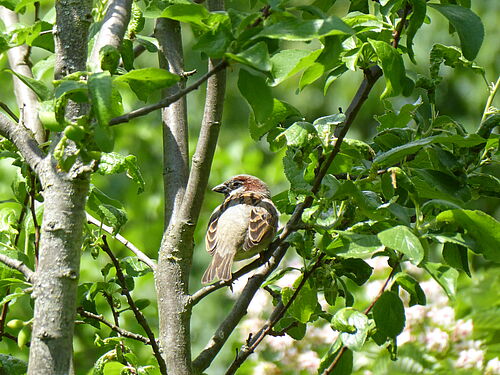
Vineyards offer potentially attractive habitat conditions for avifauna: The woody structures of vines, revegetation between vine rows, and a mosaic with adjacent unused structures can provide suitable habitat elements for many species. In many cases, however, viticulture is characterised by intensive management regimes with frequent disturbance events such as tillage, pesticide application and/or mowing of the species-poor grassed alleys and removal of marginal structures.
Various studies show that these factors in particular have a great influence on bird diversity in monocultures, which is why the influence of landscape structures and management regimes on bird diversity over the course of the year is to be investigated in this PhD project using the example of the Rheingau and Rheinhessen. Based on these results, a landscape-specific adaptable action concept for the promotion of bird diversity in wine-growing areas will be developed.
Birds
Background:
Methods of intensive land use and structural impoverishment of landscapes have been shown to have a strong negative impact on biodiversity in agricultural habitats (e.g. Chamberlain et al. 2000; Arlettaz et al. 2012). Due to increasing population numbers and growing yield demands on less land, the sustainable management of useful biotope types in agricultural landscapes has become a key topic of biodiversity research (Chapin et al. 2000). Birds of agricultural landscapes, more than any other bird species group, have experienced massive population declines throughout Germany and Europe in recent years (DO-G & DDA 2011; Wahl et al. 2015). The majority of the research projects carried out in this regard relate to annual crops (Pithon et al. 2015). However, permanent crops, such as orchards, vineyards and wood plantations, have received little attention in biodiversity research to date (Tandini et al. 2012).
Research Objective:
The research objective of this thesis is to analyse bird diversity in German wine-growing areas by demonstrating the influence of landscape structure diversity and management regimes, using the examples of Rheingau and Rheinhessen, and to derive a biodiversity-promoting management concept from this.
AFIW: Compensation areas for transport infrastructure projects in the light of climate and landscape change
The aim of the transnational project of the D-A-CH countries is to reduce long term impairments to the performance and functionality of the natural balance and the landscape caused by transport infrastructure projects.
The new project will be launched at the Institute for Landscape Planning and Nature Conservation at the end of 2022. How can the long term impacts on nature and landscape caused by transport infrastructure projects be compensated in a more sustainable and binding way? The transnational project analyses and presents the implementation practice of compensation areas as well as the existing compensation area registers and eco-account regulations. In addition, the current national legal framework conditions will be presented. In addition to recording the status quo, recommendations for the sustainable development of compensation areas in transport infrastructure projects are to be developed by linking ecology, planning and law. A special focus is placed on the future challenges of climate and landscape change.
AFIW
Project start: 01.08.2022
Project end: 31.12.2024
Project management:
Raphael Süßenbacher (E.C.O, project leader AT), Marianne Darbi (HGU, subproject leader DE), Juliane Albrecht (IÖR, subproject leader DE), Robert Meier (ARNAL, subproject leader CH)
Summary
Motorway and motorway projects regularly lead to the impairment of nature and landscape. In order to compensate for these interventions, the instrument of compensatory measures exists. The legal provisions as well as the practical implementation of compensatory measures are very inconsistently regulated. Both between the D-A-CH countries (Germany, Austria, Switzerland) and within these individual countries due to federal structures. This ultimately leads to the fact that no long-term compensation can be guaranteed. In addition, the long-term planning and management of compensation measures is increasingly challenging due to changes in climate and landscape.
For this reason, the central contents of compensation measures are analysed and presented on a transnational basis. The central objective is, in addition to the summarised presentation of the status quo for all D-A-CH countries, in particular the formulation of implementation recommendations for practice. This concerns both the basic legal framework and the concrete implementation practice, in which special instruments are also examined with compensation area cadastres and eco-controls.




